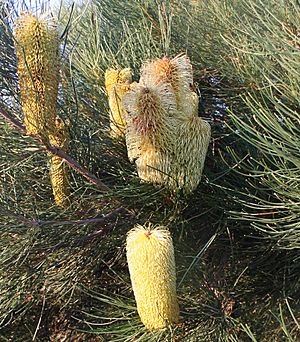Lesueur banksia facts for kids
Quick facts for kids Lesueur banksia |
|
|---|---|
 |
|
| B. tricuspis roadside planting in Wanneroo |
|
| Conservation status | |
| Scientific classification | |
| Kingdom: | |
| (unranked): | |
| (unranked): | |
| Order: | |
| Family: | |
| Genus: | |
| Subgenus: | |
| Section: | |
| Series: |
Banksia ser. Tricuspidae
A.S.George
|
| Species: |
B. tricuspis
|
| Binomial name | |
| Banksia tricuspis Meisn.
|
|
The Lesueur banksia, also called pine banksia, is a special plant found only in a small part of Western Australia. Its scientific name is Banksia tricuspis. It belongs to the Proteaceae plant family. This plant is either a small, bushy tree or a shrub. It has thin leaves and bright golden flowers that grow in cylinder shapes. You can only find it in an area of about 15 square kilometres near Jurien.
Contents
What the Lesueur Banksia Looks Like
The Lesueur banksia is a shrub or a small tree. It often has an uneven shape. It can grow up to about 4 metres (13 feet) tall. Its trunk has thick, grey, wrinkled bark. This bark helps protect the tree from fire.
Leaves and New Growth
New parts of the plant grow in the spring. They are a pale greenish-brown colour. The leaves are mostly found close to the ends of the branches. They are long and thin, about 5 to 13 centimetres (2 to 5 inches) long. Their edges are rolled under, and each leaf ends with three sharp points, like teeth.
When the leaves are new, they have soft hairs on top. As they get older, the top surface becomes smooth. The underside of the leaves is covered in a soft, woolly fuzz.
Flowers and Seeds
Like many other plants in the Banksia group, the Lesueur banksia has flower spikes. These spikes can hold hundreds or even thousands of tiny flowers. Each small flower has a tube-shaped part called a perianth, made of four joined sections. It also has a long, thin part called a style.
The flower spike grows at the end of a branch. When the flowers open, the spike is about 7 to 15 centimetres (3 to 6 inches) long. It is also about 7 to 9 centimetres (3 to 4 inches) wide. Each small flower is golden-yellow and about 2.3 to 2.6 centimetres (1 inch) long. They are hairy on the outside but smooth inside.
The Lesueur banksia flowers from late March to July. Only a few flowers on each spike, up to 35, will turn into seeds. These seeds are held inside large, woody fruits called follicles. These fruits stick out from the flower spike. They are oval-shaped, about 0.8 to 1.6 centimetres (0.3 to 0.6 inches) high and 1.5 to 2.8 centimetres (0.6 to 1.1 inches) wide. They are smooth but a bit rough. The fruits stay closed until a fire heats the plant. After a fire, one or two winged seeds are released from each fruit.
How it Got its Name
The Lesueur banksia was first officially described in 1855. This was done by a scientist named Carl Meissner. He used plant samples collected by James Drummond.
The scientific name tricuspis comes from a Latin word. It means "having three points." This name refers to the three pointed teeth found on the tips of the plant's leaves.
This plant is so unique that it is placed in its own special group. This group is called Banksia ser. Tricuspidae.
Where the Lesueur Banksia Lives
This banksia plant is only found in one specific area. It grows around Mount Lesueur in Lesueur National Park. This park is in the Geraldton Sandplains area of Western Australia. It prefers to grow in rocky, lateritic soil. This type of soil is rich in iron and aluminium. It grows in areas with low, dense shrubland plants.
Life Cycle and Ecology
The Lesueur banksia is good at surviving fires. After a fire, new shoots can grow from special buds under its bark. These are called epicormic buds. This helps the plant recover and regrow.
There is also evidence that black cockatoos help this plant. These birds might increase how many seeds the plant produces. They do this by eating boring insects that could harm the plant's seeds.
Protecting the Lesueur Banksia
The Government of Western Australia's Department of Parks and Wildlife has listed Banksia tricuspis as "Priority Four". This means it is a rare plant or nearly threatened. It is only found in a very small area, about 15 square kilometres (6 square miles). Because it grows in such a small space, it is important to protect its habitat.
Growing Lesueur Banksia at Home
This banksia plant grows slowly. It might take 10 years for it to flower for the first time. The leaves are not very dense, except at the branch tips. However, its flower spikes and old fruits are quite attractive.
It grows best in sandy or rocky soil. It also needs a sunny spot to thrive. The seeds do not need any special treatment to grow. They usually take between 18 and 57 days to sprout.
Images for kids
-
B. tricuspis habit in Lesueur National Park
-
B. tricuspis young inflorescence





